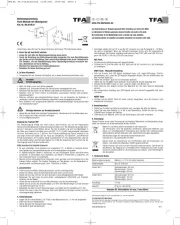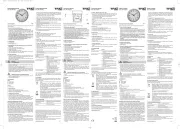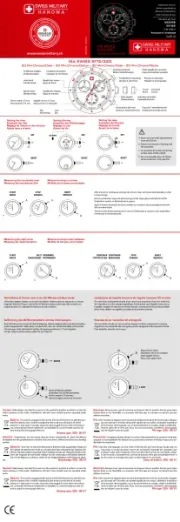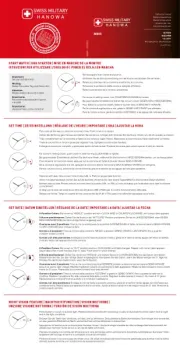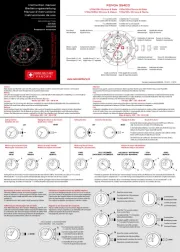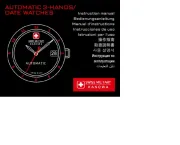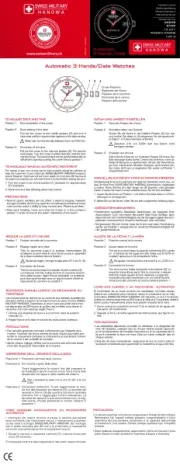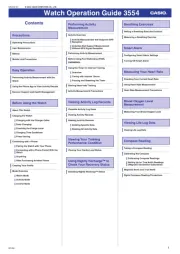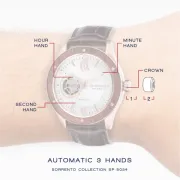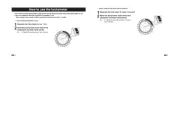
• Funkuhr mit höchster Genauigkeit
• Analoge Anzeige mit Zeiger
Die Zeitübertragung erfolgt von einer Cäsium Atom-Funk-
uhr, die von der Physikalisch Technischen Bundesanstalt in
Braunschweig betrieben wird. Die Abweichung beträgt
weniger als 1 Sekunde in einer Million Jahren. Die Zeit ist
kodiert und wird von Mainflingen in der Nähe von Frankfurt
am Main durch ein DCF-77 (77.5 kHz) Frequenzsignal über-
tragen mit einer Reichweite von ca. 1.500 km. Ihre Funkuhr
empfängt das Signal, wandelt es um und zeigt immer die
exakte Zeit an. Auch die Umstellung von Sommer- und Win-
terzeit erfolgt automatisch. Der Empfang hängt hauptsäch-
lich von der geographischen Lage ab. Im Normalfall sollten
innerhalb des Radius von 1.500 km ausgehend von Frankfurt
bei der Übertragung keine Probleme auftauchen.
Bitte beachten Sie folgende Hinweise:
• Es wird empfohlen, einen Abstand von mindestens 1,5 –
2 Metern zu eventuell störenden Geräten wie Computer-
bildschirmen und Fernsehgeräten einzuhalten.
• In Stahlbetonbauten (Kellern, Aufbauten) ist das empfan-
gene Signal natürlicherweise schwächer. In Extremfällen
wird empfohlen, das Gerät in Fensternähe zu platzieren,
um das Funksignal besser zu empfangen.
• Nachts sind die atmosphärischen Störungen meist geringer
und ein Empfang ist in den meisten Fällen möglich. Ein
einziger Empfang pro Tag genügt, um die Genauigkeit zu
gewährleisten und Abweichungen unter 1 Sekunde zu hal-
•Entfernen Sie Nadel zur Transportsicherung.
• Legen Sie die Batterie (1 x 1.5 V AA) ein, +/- Pol wie abge-
bildet. Das Gerät ist jetzt betriebsbereit.
• Die Uhr stellt sich auf 12 h und versucht nun, das Funk-
signal 10 min. lang zu empfangen. Wenn der Zeitcode
empfangen wurde, wird die funkgesteuerte Zeit ange-
zeigt. Sollte kein Zeitcode empfangen worden sein, wird
der Empfang zu jeder vollen Stunde erneut aktiviert. Ins-
gesamt gibt es 14 Versuche.
• Sie können die Initialisierung auch manuell starten.
Drücken Sie die rechte “REC” Taste auf der Rückseite für
• Falls die Funkuhr kein DCF-Signal empfangen kann (z.B.
wegen Störungen, Übertragungsdistanz, etc.), kann die
Zeit manuell eingestellt werden. Die Uhr arbeitet dann
wie eine normale Quarz-Uhr.
• Halten Sie die linke “M.SET” Taste auf der Rückseite für
3 Sekunden gedrückt, und Sie können die Uhrzeit ein-
• Schwache Batterien sollten möglichst schnell ausgetauscht
werden, um ein Auslaufen der Batterien zu vermeiden.
Batterien enthalten gesundheitsschädliche Säuren. Beim
Hantieren mit ausgelaufenen Batterien beschichtete Hand-
schuhe und Schutzbrille tragen!
•Achtung: Bitte entsorgen Sie Altgeräte und leere Batterien
nicht über den Hausmüll. Geben Sie diese bitte zur
umweltgerechten Entsorgung beim Handel oder entspre-
chenden Sammelstellen gemäß nationaler oder lokaler
• Setzen Sie das Gerät keinen extremen Temperaturen,
Vibrationen und Erschütterungen aus.
• Reinigen Sie das Gerät mit einem weichen, leicht feuchten
Tuch. Keine Scheuer- oder Lösungsmittel verwenden!
• Das Gerät ist kein Spielzeug. Bewahren Sie es außerhalb
der Reichweite von Kindern auf.
• Diese Anleitung oder Auszüge daraus dürfen nur mit
Zustimmung von TFA Dostmann veröffentlicht werden.
• Unsachgemäße Behandlung oder nicht autorisiertes Öff-
nen des Gerätes führt zum Verlust der Garantie.
DESIGN - Radio controlled wall clock
• Highest precision radio-controlled clock
• Analogue display with hands
Radio controlled time reception:
The time base for the radio controlled time is a Caesium
Atomic Clock operated by the Physikalisch Technische
Bundesanstalt Braunschweig which has a time deviation of
less than one second in one million years. The time is coded
and transmitted from Mainflingen near Frankfurt via fre-
quency signal DCF-77 (77.5 kHz) and has a transmitting
range of approximately 1,500 km. Your radio-controlled
clock receives this signal and converts it to show the precise
time in summer or wintertime. The quality of the reception
depends greatly on the geographic location. In normal cases,
there should be no reception problems within a 1,500 km
Please take note of the following:
• Recommended distance to any interfering sources like com-
puter monitors or TV sets is a minimum of 1.5 - 2 metres.
• Within ferro-concrete rooms (basements, superstructures),
the received signal is naturally weakened. In extreme
cases, please place the unit close to a window.
• During night-time, the atmospheric disturbances are
usually less severe and reception is possible in most cases.
A single daily reception is adequate to keep the accuracy
deviation below 1 second.
• Insert 1 x AA size 1.5 V alkaline battery as indicate by the
polarity. The unit is now ready to use.
• After the initial setup, the display shows 12 o’clock and is
trying to receive the radio signal for 10 minutes. When the
time code is received, the radio-controlled time and date
will be displayed. If the reception fails, scanning stops and
will be repeated again every solid hour. The reception will
• Manual initialization can be helpful. Hold the right “REC”
button on the backside for 3 seconds.
• In case the clock cannot detect the DCF-signal (for exam-
ple due to disturbances, transmitting distance, etc.), the
time can be set manually. The clock will then work as a
• Hold the left “M.SET” button on the backside for 3 seconds
• Low batteries should be changed soon to avoid the damage
resulting from a leaking battery. Batteries contain harmful
acids. Wear protective glasses and gloves when handling
Please do not dispose of old electronic devices and empty
batteries in household waste. To protect the environment,
take them to your retail store or to appropriate collection
sites according to national or local regulations.
• Do not expose the instrument to extreme temperatures,
• Clean it with a soft damp cloth. Do not use solvents or
• The product is not a toy. Keep it out of reach of children.
• No part of this manual may be reproduced without written
• Improper use or unauthorized opening of housing will
mean the loss of warranty.
DESIGN - Horloge murale radio pilotée
• Horloge radio-pilotée de la plus extrême précision
• Affichage analogue avec aiguille
• Avec aiguille des secondes
Réception de l’heure radio:
La transmission de l’heure radio s’effectue selon une horloge
atomique au césium, exploitée par la Physikalisch Technische
Bundesanstalt de Braunschweig (Institut Fédéral Physico-Techni-
que de Braunschweig). L’écart de précision de cette horloge est
de 1 seconde pour un million d’années seulement. L’heure est
distribuée à partir de Mainfingen, près de Francfort sur le Main,
par un signal DCF-77 (77,5 kHz), avec une portée d’environ 1,500
km. Votre horloge radio pilotée reçoit ce signal, le convertit et
affichera ainsi toujours l’heure exacte. Le passage de l’heure d’hi-
ver à l’heure d’été et vice-versa s’effectue également en mode
automatique. La réception est essentiellement fonction de votre
position géographique. En règle générale, dans un rayon de
1,500 km autour de Francfort, aucun problème de transmission
Nous vous prions de respecter les consignes ci-après:
• Nous vous recommandons de ménager une distance de 1,5 à
2 m entre l’appareil et d’éventuelles sources de signaux
parasites, comme les écrans d’ordinateur et les postes de
• Dans les bâtiments en béton armé (caves, greniers amé-
nagés), le signal reçu est affaibli. Dans les cas extrêmes, nous
vous conseillons de placer l’appareil près d’une fenêtre pour
améliorer la réception du signal radio.
• La nuit, les perturbations s’affaiblissent en règle générale, et
la réception est possible en plupart des cas. Un seul créneau
de réception par jour suffit, pour garantir la précision de
l’affichage de l’heure, et pour maintenir d’éventuels écart
• Insérer la batterie (1 x 1.5 V AA), polarité +/- comme illustré.
L´instrument est maintenant prêt à fonctionner.
• Après la première mise en service l'horloge s'ajuste à 12 H
et tente de capter le signal radio pour 10 minutes. Dès la
réception du code horaire, l’heure radio s’affiche. Si l’heure
radio ne s’affiche pas, la réception est actualisée chaque
grande heure. Le nombre total est 14 tentatives.
Vous pouvez activer manuellement la réception de l’heure radio.
Appuyez sur la touche droite «REC» au verso pendant 3 sec.
• Si votre réveil radio piloté ne peut pas recevoir le signal
DCF (p. ex. en raison de la présence de perturbations,
d’une distance de transmission excessive etc.), vous pouvez
procéder à un paramétrage manuel. L'horloge fonctionne
alors comme une pendule à quartz normale.
• Appuyez sur la touche gauche «M.SET» au verso pendant
3 sec., et il est possible de régler l'heure.
• Les batteries faibles doivent être changées le plus rapide-
ment possible, afin d'éviter une fuite des batteries. Les
batteries contiennent des acides nocifs pour la santé. Pour
manipuler des batteries qui ont coulé, utiliser des gants
spécialement adaptés et porter des lunettes de protection !
•Attention: Les vieux appareils électroniques et piles usagées
ne doivent pas être jetées dans les détritus ménagers. Veuil-
lez les rendre dans un site approprié de récupération pour
les enlever sous des conditions de milieu ou chez votre
revendeur selon les spécifications nationales et locales.
• Evitez d’exposer l’appareil à des températures extrêmes,
• Pour le nettoyage du display et du boîtier, utilisez un chiffon
doux humide. N’utilisez pas de dissolvants ou d´agents
• L'appareil n'est pas un jouet. Maintenir l'appareil hors de
• Ce mode d'emploi ou des extraits de celui-ci peuvent être
publiés exclusivement avec l'approbation du TFA Dostmann.
• Toute utilisation non conforme ou l'ouverture non auto-
risée de l'appareil provoque la perte de la garantie.
Instrucciones para el manejo
TFA Anl_No. 98.1094_95_96_97 24.06.2008 10:39 Uhr Seite 1 (Schwarz/Process Black Auszug)


